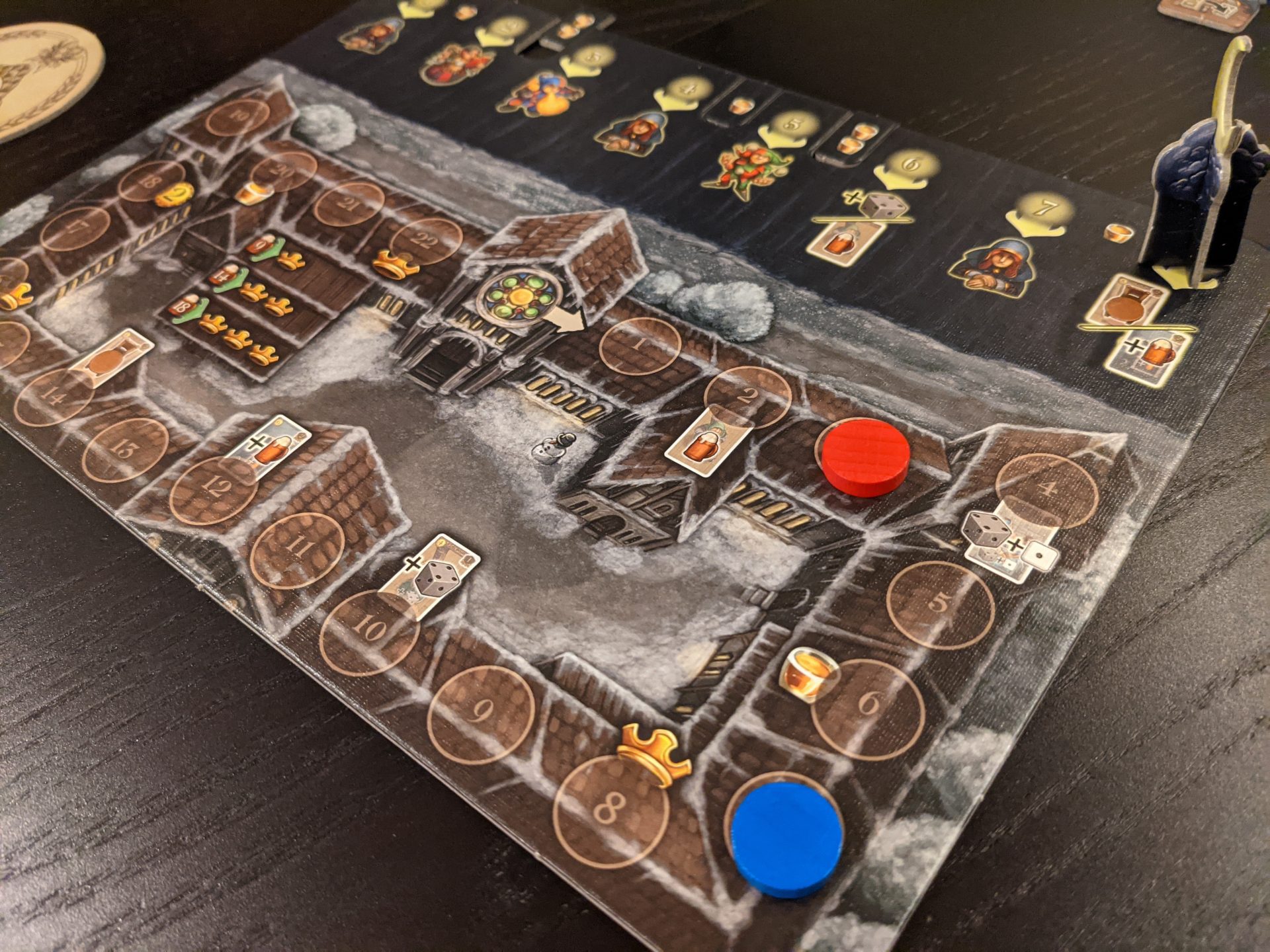Everyone has a favorite designer; some of my game group friends pray at the altar of Cole Wehrle (Oath, Root, Pax Pamir); others love Vital Lacerda (On Mars, Lisboa, Kanban EV), while a few others really love everything by Alexander Pfister (Great Western Trail, Mombasa, Maracaibo).
But those are all medium to heavyweight games. When I want to look through the games that will play well with ANY style of gamer, I don’t have to think very hard:
Wavelength is my favorite party game of the last ten years; yes, even more than Codenames. The “Clever” games are roll-and-write gems that have come to be the definitive take on the genre (even if our friends at No Pun Included believe that foxes are the only way to score big). The Quacks of Quedlinburg is easily the best game of all time with a bad title, if its current rank on the BGG Top 100 is any indication, and “press your luck” hasn’t been that much fun since watching the actual TV show called Press Your Luck!
And you can dog The Mind all you want, haters…yes, it’s a deck of 100 very plainly-designed cards, but it was the only time at a Gen Con that I screamed, out loud, while playing a game. That’s what happens when you get through the final round of The Mind and come out a winner; it’s truly an amazing moment. And that game now only costs $10.
So it should be no surprise that I’m interested any time I see the words “designed by Wolfgang Warsch” on a game box. And that means you don’t have to read much further to know what I think about The Taverns of Tiefenthal, a game featuring beer, dice, schnapps, barmaids and giving bad customers the boot from your deck of cards.
But, let’s assume you really DO want to keep reading. I’ll spend the rest of our time together telling you why you should definitely own this game.

The Teach is a Snap
The Taverns of Tiefenthal mixes two of my favorite mechanisms: deck building and dice placement/activation. Players assume the roles of tavern owners in the small village of Tiefenthal; the player with the most successful tavern will win after playing eight rounds.
Personal player boards in board games really run the gamut right now; in The Taverns of Tiefenthal, your player board is your tavern! You’ve got areas to store beer and cash, employ dishwashers and servers, and keep space for entertainers in order to keep your guests happy.
In each round, all players will have a draw deck; at the start of the game, this deck is pretty bare. It is chock full of cheap patrons who will clog up your deck unless you can kick them out of your bar forever. The deck also starts with a single Brewer (used to make beer), a Table (which gives your player board more space to seat Guests) and one server, which can give you an extra die for personal use during a round to activate parts of your bar.
Turns are quick in The Taverns of Tiefenthal, because many of the turn steps are simultaneous amongst all players.
First, you’ll draw cards from your personal deck until there are Guests placed on each Table printed on your player board or drawn as cards during this phase. Early on, you’ll mostly have Guests in your deck, and the problem with these initial Guests is that they almost all have the same number of pips required to activate. Those pips tell you how much money they will pay to get a beer. Since those numbers are low, you will have few choices to buy quality cards.
Players will then roll four white, general supply dice along with any colored dice provided by their Servers, setting aside those colored dice for personal use in a moment. Once rolled, players place their four white dice on a coaster in front of them to draft one of the four dice near their player board. Then, all players pass their coaster and the remaining dice on top to their left, repeating this process until each player has four white dice and up to three personal dice for placement during the round.
As a player, you’ll survey the drafted dice to see where you can place them on your player board to either earn Thalers (cash) or Beer. Thalers are used to upgrade parts of the tavern or buy Staff and Equipment to place on the top of your deck, to be played in the next round.
Beer is important for one thing: attracting the best drinkers in the small town of Tiefenthal, and the best Guests cost the most Beer. These upgraded Guests often give players a one-time bonus when acquired, in addition to featuring more variety in your deck. This is crucial: you’ll need more ways to use 3s, 4s, and 5s on dice when you have to draft, because 1s and 6s are vital in The Taverns of Tiefenthal for use of the Brewer as well as activating many of the crappy Guests which start the game in your deck.
If you have enough coins, you’ll be able to permanently upgrade parts of your tavern: a permanent Server, or maybe a Brewer which gives you two Beers for every 1 or 6 instead of just one. More importantly, each time you upgrade the tavern, you’ll get to add a Noble card to your deck, which is worth 10 points at the end of the game.
One of my favorite bonuses with the Nobles? They like to congregate together when going out, so if multiple Nobles appear when you are drawing cards, you can stack all of them at the same table on your player board. (Nice work, Wolfgang!!)
In some rounds, you’ll have a few Thalers or Beers left over; there are ways to store a couple of each of those when you start the game, but upgrading the storage areas of the tavern (the Cashbox and the Beer Storage) becomes important later so that you can save up larger totals to buy the best Guests and Tavern upgrades.
The Taverns of Tiefenthal goes on like this for eight rounds, and at the end, victory points from Nobles, other Guests, and Staff cards are tallied. Whoever has the most points wins, and for the tiebreaker, whoever has stored up the most Thalers and Beers wins.

Variability in Spades
In classic Wolfgang Warsch fashion, you can play the base game rules of The Taverns of Tiefenthal with almost any kind of gamer. But the core box includes four mini-expansions known as Modules that scale nicely with gamers of more advanced shades. (Kudos to North Star, because these mini-expansions are included in the core box and don’t cost extra. Why can’t more publishers just provide me with a few small options right out of the box???)
The core box is known as “Module 1.” Module 2, “Schnapps—That Was His Last Word,” introduces Schnapps, an added currency for special actions to trigger game-breaking abilities with Entertainers, double-sided tiles which allow players to spend Schnapps to do things like immediately upgrade a part of your tavern, trash Guests from your deck, or other cool game effects.
Module 3, “Your Reputation Precedes You,” goes even further by adding a Reputation Track to the bottom of the player board. This track allows players to take the difference between Thalers and Beer produced in a round to move along and gain bonuses like take Schnapps tokens or even gaining a Noble card each time the Reputation marker revolves around the track.
Module 4, “Every Beginning is Difficult,” adds variability to the start of each game of The Taverns of Tiefenthal by offering three options for players to choose from to go into their starting draw deck. Module 5, “The Later the Hour, The Nicer the Guests”, basically adds a Bingo board known as the Guest Book to your tableau; as you recruit new Guests, you’ll cover parts of your Guest Book with small tiles aligned with the cost in Beers of each guest. As you fill up rows and columns on the Guest Book, you’ll earn additional bonuses.
The base game, Module 1, will offer enough for many gamers, particularly those who are new to the hobby. For my gaming group, I always play with Modules 2 and 3; to me, for a medium-weight, experienced gamer up through someone who enjoys heavy games, this is perfect and can hum in under an hour with four experienced players.
I’ve still never used the variable setups in Module 4 and we’ve never needed more ways to score, like what is provided by Module 5. That said, you can play with any of these expansions or none of them and still get a ton out of the experience.

Grab a Beer (and This Game!)
The Taverns of Tiefenthal works on a variety of levels. First, the theme just works better for me than The Quacks of Quedlinburg; running a bar and the thematic elements behind making a bar successful just click more than making potions and grabbing random tokens from a bag. (Love Quacks! Just not as much as Taverns.) Next, I have played The Taverns of Tiefenthal with such a wide variety of gamers: core, hardcore, casual, non-gamers who wanted to dabble in games beyond their comfort zone. It also plays really well at 2, 3 and 4 players; because so many of the phases each turn are simultaneous, you’re only talking about another 15-20 minutes of playtime when going from 2 to 4 players.
My main “complaint” with The Taverns of Tiefenthal—and even this is a stretch—is the Monastery Board. This is a secondary board that features cool bonuses but is essentially never featured in my plays because no one invests early on in upgrading the Monk action on the player board. The Monk allows a player to move up one space on the Monastery track, but the bonuses on it are fairly weak. You’ll be able to get one Noble card on space 8, but in my experience players don’t get to that space until very late in the game. I’ve never seen anyone advance around the board even halfway.
Worse than that, though? It’s the cheat sheet on the middle of the Monastery board hiding in plain sight: you can, at any time on a turn, spend 9 beers to get one Noble, or 14 to get two Nobles, or 18 to get three Nobles. If you have a great Beer engine, this is an incredible way to score 10-30 points near the end of the game once you no longer want to spend Beers on new Guests to go into your deck. That should be printed everywhere in the game, but especially on each player board.
Monastery Board aside, The Taverns of Tiefenthal is a fabulous game. I truly believe it is not higher on the BGG boards because people have not played it, because whenever I get it to the table I have a great time and other players enjoy their experience as well. Now grab a beer and put this one on the table!












Add Comment